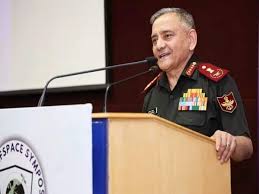Operation Sindoor Reveals Future Warfare Tactics: CDS Anil Chauhan Highlights 5 Key Takeaways
Chief of Defence Staff (CDS) General Anil Chauhan has described Operation Sindoor as a turning point in the way wars are fought, highlighting how modern warfare now depends on technology, cyber operations, and the ability to control information.
The operation began with airstrikes on nine terror camps in Pakistan and Pakistan-occupied Kashmir on May 7. But General Chauhan pointed out that the mission was much more than physical combat.
1) Operation Sindoor shows ‘multi-domain’ shift
Speaking at the Shangri-La Dialogue in Singapore, General Chauhan said the Operation Sindoor was “non-contact” and “multi-domain,” relying not just on traditional military action but also on cyber capabilities, intelligence, disinformation management, as well as the coordination of multiple forces across land, air, sea, and cyber.
He explained that this shift changes how battles are fought – moving away from large, fixed military platforms to flexible and deceptive strategies.
“Modern warfare is undergoing a complex convergence of tactical, operational and strategic layers; old and new domains (land, air, sea, cyber and space); and even of time and space,” news agency ANI quoted Anil Chauhan, as saying.
2) 15% of forces’ efforts spent on countering disinformation
One of the major challenges during Operation Sindoor was disinformation. General Chauhan said that as much as 15% of the armed forces’ efforts during the mission were spent countering fake news and misleading narratives.
“Combating fake news was a constant effort. Our communication strategy was deliberate; we chose to be measured, not reactive, because misinformation can quickly distort public perception during high-stakes operations,” he said.
India should focus on controlling the narrative using verified facts and evidence, even if it results in a slower response to the public, Chauhan added.
To illustrate this, he gave an example of how India handled public communication in the early days of the operation. “In the first three days, two women officers were our primary spokespeople because the actual military leadership were directly engaged in fast-moving operations. It was only after the 10th that the DGMOs came forward to brief the media.”
3) India remained resilient against cyber attacks
On the use of cyber capabilities, the CDS noted that while cyberattacks occurred on both sides, their impact on core military systems was minimal.
“Our military systems are air-gapped, meaning they’re not connected to the internet and are therefore largely secure. Attacks on public-facing platforms like school websites may have occurred, but they did not affect operational systems,” the CDS explained, reported ANI.
4) Integrated tech and real-time networking are key
He further stressed the need for integrated technology in warfare. “What matters most in modern warfare is the networking of systems and real-time integration across air, land, sea and cyber domains. If you have great tech but it’s not connected, you can’t fully leverage it.”
In his discussions with global think tanks, Chauhan noted that India is preparing for the future of warfare by embracing technology, joint operations, and better narrative control – elements he said were all demonstrated in Operation Sindoor.
The General pointed out that today’s conflicts are not linear. “We’re no longer fighting linear wars; we’re operating across distributed networks, applying force in non-linear ways, where deception is becoming more important than surprise,” he said.
5) Military overhaul needed with focus on specialised units, joint training
New capabilities like drones and electronic warfare tools will require specialized units. “We’ll need separate organisations for drones, EW, UTAPs (Unmanned Teaming Aerial Platforms), etc,” he said.
General Chauhan also highlighted the importance of reform in military structure and training. He said India is moving toward more integrated and agile forces.
“Earlier we didn’t have true jointness or integration in the military. Now, after initiatives and operational experiences, we are moving toward integrated commands and leaner, more flexible structures.”
He added that India’s professional military education is also evolving. “For the first time, we have a truly joint staff course where 40 officers from all three services train together for a full year. That’s a major shift.”
Also Read: Pakistan’s ISI Network in India: Engineer, Influencer, and Govt Official Among Arrested Spies








